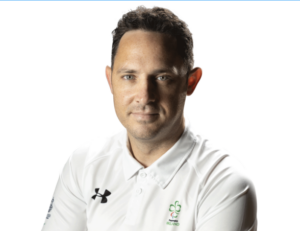About Our Founder
Phil Eaglesham is a former Royal Marines Commando who contracted Q Fever whilst on his third Operational tour of duty in Afghanistan. Within a couple of months, Phil relied on mobility devices and eventually was bound to a powered wheelchair with 24hr care. Not letting it hold him back, Phil drew on the Commando Mindset and has gone on to became a two-time Paralympian, competing in target shooting at the Rio 2016 and Tokyo 2020 Paralympic Games.
Alongside his paralympic endeavours, Phil has fulfilled a decade-long desire to improve the lives of wheelchair and mobility device users worldwide.
In 2015, after experiencing a mental health crisis due to being stigmatised and forced to use devices unfit for purpose, Phil set about outlining a brief for what he wanted in a powered wheelchair. He had multiple wheelchairs for different capabilities, yet they all lacked the specifications needed to empower him to be independent. The powered wheelchair market needed change in both design and functionality, encompassed in a single device. It lacked the foresight and innovation that the prosthetic limb sector had already achieved.
After being told many times not to enter the industry because it was “dominated by a number of larger companies”, Phil saw it as a challenge to breathe fresh air into an otherwise stagnant market. Supported by his wife and carer, Julie, the pair believed they could make a difference to their own family dynamic and hopefully others like them.
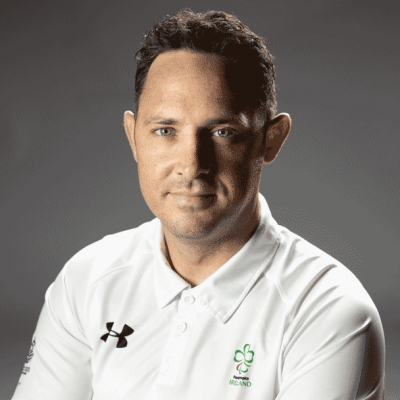
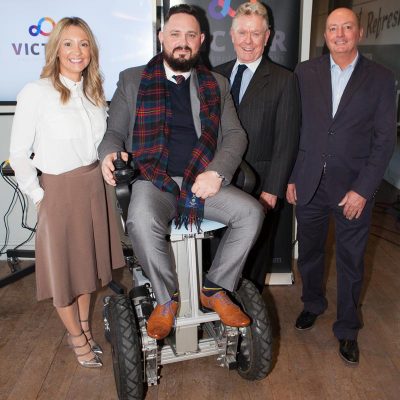
A Chance meeting
By chance, Phil and Julie met prominent local businessman Brian Meaden at a Royal Marines Charity function. The trio shared a common belief that something needed to be done. They set about searching for industry-leading engineers to take on the challenge. Brian, an alumnus of the University of Sheffield, made enquiries, and the trio were introduced to the Advanced Manufacturing and Research Centre (AMRC), affiliated with the University of Sheffield.
The AMRC team saw the vision and started by spending time using powered wheelchairs, mobility scooters, and other mobility devices to understand their limitations. Phil provided a brief outlining what was required, focusing on:
- Aesthetics at the forefront.
- New functional wheels to replace outdated caster wheels that frequently become blocked or stuck.
- A single device to achieve what currently requires two or three different devices.
- A wheelchair that could withstand robust daily use without frequent breakdowns or failures.
A Chance meeting
By chance, Phil and Julie met prominent local businessman Brian Meaden at a Royal Marines Charity function. The trio shared a common belief that something needed to be done. They set about searching for industry-leading engineers to take on the challenge. Brian, an alumnus of the University of Sheffield, made enquiries, and the trio were introduced to the Advanced Manufacturing and Research Centre (AMRC), affiliated with the University of Sheffield.
The AMRC team saw the vision and started by spending time using powered wheelchairs, mobility scooters, and other mobility devices to understand their limitations. Phil provided a brief outlining what was required, focusing on:
- Aesthetics at the forefront.
- New functional wheels to replace outdated caster wheels that frequently become blocked or stuck.
- A single device to achieve what currently requires two or three different devices.
- A wheelchair that could withstand robust daily use without frequent breakdowns or failures.

Developing Ideas
The AMRC and Conquering Horizons teams spent time developing ideas, designs, and concepts that would challenge the narrative. They analysed UK legal constraints, from the requirement that a device must have at least three wheels to the specifications needed for a Class 3 device to be used on pavements and roads.
The prevailing belief was that users needed multiple wheelchairs: one for indoor and light outdoor living, another for off-road use, one for road use, and a specialised chair for height adjustment and tilt-in-space functionality. Phil believed that a single wheelchair could be designed and built to perform all these tasks in one, with both function and style as must-haves. From this belief, the initial concept was born.
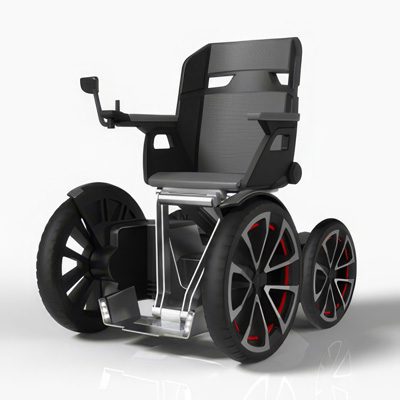

The Royal Marines Charity
Phil took the concept to RMA – The Royal Marines Charity, which had unwaveringly supported him and his family through his illness. The Royal Marines Charity, alongside BLESMA, took an in-depth look at the concept. With their extensive experience supporting injured servicemen and women, they understood the problems identified. RMA – The Royal Marines Charity, with support from Greenwich Hospital, granted Phil £60,000 to get the concept off the ground and produce an initial working prototype to prove the feasibility of the design.
Following the successful production of the prototype, the company required funding to develop fully functional concept prototypes. Conquering Horizons partnered with Crowdcube to raise the necessary equity. After a successful crowdfunding campaign, over £500,000 was raised from more than 500 investors who shared Phil’s vision. The AMRC team set about developing two working concept prototypes.
The Royal Marines Charity
Phil took the concept to RMA – The Royal Marines Charity, which had unwaveringly supported him and his family through his illness. The Royal Marines Charity, alongside BLESMA, took an in-depth look at the concept. With their extensive experience supporting injured servicemen and women, they understood the problems identified. RMA – The Royal Marines Charity, with support from Greenwich Hospital, granted Phil £60,000 to get the concept off the ground and produce an initial working prototype to prove the feasibility of the design.
Following the successful production of the prototype, the company required funding to develop fully functional concept prototypes. Conquering Horizons partnered with Crowdcube to raise the necessary equity. After a successful crowdfunding campaign, over £500,000 was raised from more than 500 investors who shared Phil’s vision. The AMRC team set about developing two working concept prototypes.

Award Winning
This success led the Institution of Engineering Designers (iED) to present Phil with the Alex Moulton Award in 2018 in recognition of his work in developing an innovative product. He joined an esteemed list of previous winners, including Apple designer Jonathan Ive and Raspberry Pi founder Pete Lomas.
Having gained insight into the future of wheelchair design, Conquering Horizons enlisted Supacat Group, experts in military off-road vehicle design, to meet the demands of tomorrow’s world. Their task was to refine the AMRC’s working concepts into pre-production models that were fit for purpose and robust for everyday use. Using their extensive military vehicle expertise, they also assessed the manufacturing and production processes required for a commercial product.
To oversee this stage, Conquering Horizons appointed Andy Reeson as Technical Manager to work alongside Supacat Group. After evaluating the prototypes, the decision was made to switch to a 48V system and develop bespoke software. The goal was to move away from what Phil saw as outdated aesthetics in the controls. This was no small feat, but it was essential to achieving the desired outcome.
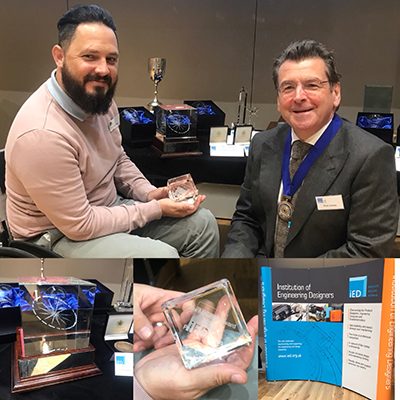
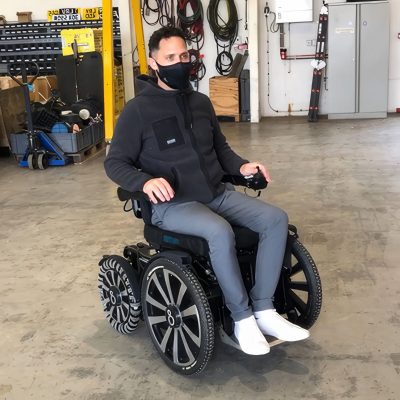
Covid hit the world
Phil also set a brief for seating development. He envisioned an adaptive seating system that changed with the user’s physique, was aesthetically pleasing, and ensured that the user was seen first and foremost—not the wheelchair. Top medical-grade high-pressure cushioning was essential for support and comfort, moving away from the stigmatising appearance of “an armchair on wheels”, which Phil had long disliked.
As the world was struck by COVID-19 in 2019, research and development slowed to a trickle. Designers continued their work remotely as best they could, but production and part acquisition ground to a halt. With no financial support from government schemes, Phil’s vision—like many businesses at the time—was at risk of collapse. Conquering Horizons had to look inward, raising finance through a loan and a further equity investment to keep the dream alive.
Covid hit the world
Phil also set a brief for seating development. He envisioned an adaptive seating system that changed with the user’s physique, was aesthetically pleasing, and ensured that the user was seen first and foremost—not the wheelchair. Top medical-grade high-pressure cushioning was essential for support and comfort, moving away from the stigmatising appearance of “an armchair on wheels”, which Phil had long disliked.
As the world was struck by COVID-19 in 2019, research and development slowed to a trickle. Designers continued their work remotely as best they could, but production and part acquisition ground to a halt. With no financial support from government schemes, Phil’s vision—like many businesses at the time—was at risk of collapse. Conquering Horizons had to look inward, raising finance through a loan and a further equity investment to keep the dream alive.

Tokyo Paralympics
As the world reopened, Conquering Horizons and Supacat Group were able to produce two very limited pre-production prototypes, which Phil took to the postponed Tokyo 2020 Paralympic Games in August 2021. The reception was overwhelmingly positive. It was the first opportunity for the disabled community to see what Phil and his team had developed. With the world’s Paralympic athletes gathered in one place, they could compare Omni with the best mobility devices available. Phil was frequently stopped by people asking where they could buy one, confirming that there was nothing like it on the market. Omni had the potential to be a game-changer.
However, the fallout from COVID-19 disrupted global supply chains, slowing the project further. As different countries faced supply issues and international conflicts hindered shipping lanes, it became clear that getting to market would take longer than anticipated. The company decided to bring the project entirely in-house under Conquering Horizons’ control.
A deep dive into the project followed, addressing rising material, part, and supply chain costs. Every component was scrutinised for efficiency, durability, and aesthetics. Working with GSD Technologies—experts in precision engineering for the marine, medical, and aerospace industries—Conquering Horizons refined the design-for-manufacturing process to produce 12 pre-production devices for testing and evaluation.
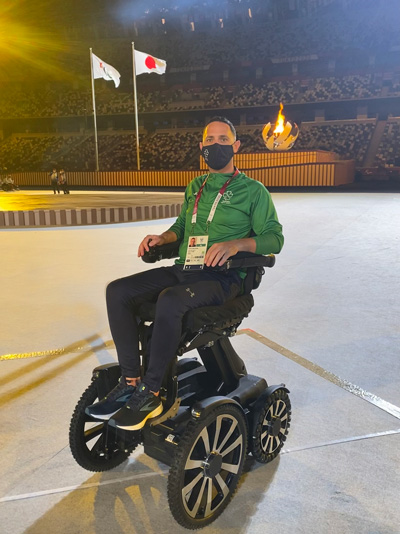

Testing
The team focused on improving manufacturing speed, cost-effectiveness, and quality while maintaining high standards. They partnered with British companies to ensure quality was not compromised. Conquering Horizons also invested in various manufacturing tools, including sand casting, vacuum forming, and injection moulding, while ensuring compliance with ISO standards and other regulatory requirements.
A rigorous testing process was implemented, including rolling road tests, drop tests, and deceleration testing, all of which Omni exceeded. Once certifications were secured, beta user testing was conducted, and the company’s pre-order book was opened.
Now, at last, the time had come to offer users the true meaning of freedom and independence. Conquering Horizons made the decision to produce a limited first production run of 25 units, making Omni available to order.
Testing
The team focused on improving manufacturing speed, cost-effectiveness, and quality while maintaining high standards. They partnered with British companies to ensure quality was not compromised. Conquering Horizons also invested in various manufacturing tools, including sand casting, vacuum forming, and injection moulding, while ensuring compliance with ISO standards and other regulatory requirements.
A rigorous testing process was implemented, including rolling road tests, drop tests, and deceleration testing, all of which Omni exceeded. Once certifications were secured, beta user testing was conducted, and the company’s pre-order book was opened.
Now, at last, the time had come to offer users the true meaning of freedom and independence. Conquering Horizons made the decision to produce a limited first production run of 25 units, making Omni available to order.

What does the future hold?
Further investment, research, and development will focus on:
Interchangeable tracks for different terrains.
Headrest design enhancements.
Accessories to improve user experience.
Phil has a long list of innovative concepts that he believes can improve the lives of the disabled community. Watch this space!

